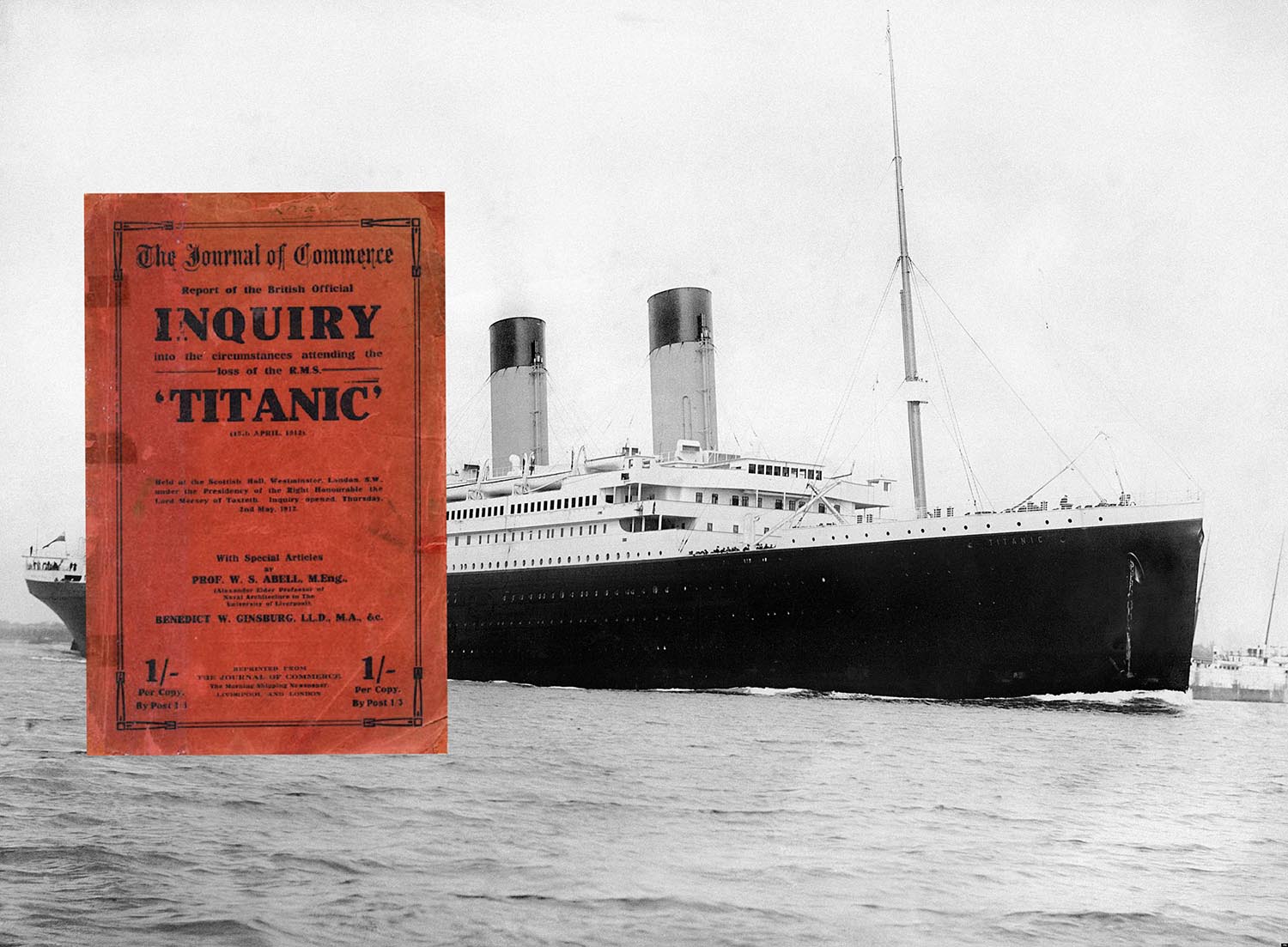
Inquiry into the Sinking of the Titanic
Brian Hannan from Abbey Books in Paisley takes a look at the Inquiry into the Sinking of the Titanic which came into the shop recently
Every now and then something turns up at the bookshop that simply takes your breath away. The John Byrne notebook was one such item. This is another.
It dates from 1912. The Sinking of the Titanic dominated news headlines in that year – and for the following century. Rather than interest abating, it has been further fuelled by the film Titanic (1997), its subsequent reissue, and other elements relating to the vessel. So actually being able to hold in your hand something of as much historical importance as this is unique.
The Journal of Commerce (“The Morning Shipping Newspaper”) printed this book based on its own comprehensive day-by-day account of the Official British Inquiry, presided over by Lord Mersey of Toxteth, into the sinking. Every word uttered at the inquiry is faithfully recorded here. Not one detail is omitted. So this is probably the most complete account of the events that led up to the tragedy, the sinking itself and the aftermath, that you could find.
The inquiry opened on Thursday 2nd May, 1912, and ran for 36 days but that account is also supplemented by the Judgement and other articles concentrating on the “engine room heroes”, as well as information regarding Lord Mersey, the five Assessors assisting him and Captain Bingham, secretary to the Court of Inquiry. The 276-page book also contains, ironically, many adverts promoting safety at sea. The book was published so that details of the inquiry “be preserved for future reference and guidance”.
Most of the details are, of course, sad to hear. Out of 60 third-class stewards only about a dozen were saved. But the publication certainly captures the atmosphere of a trial. You can sense when witnesses are being badgered and on occasion Lord Mersey will interrupt to prevent this occurring.
- Chris Forbes: local comedian and actor talks to Mill Magazine
- The Rollin Pig – Renfrewshire’s award-winning street food
- Norman Blake on gigs with Bernard Butler and James Grant
And there is interesting discussion on the iceberg. From what distance, for example, would you normally expect a sailor in the crow’s nest to be able to spot one? Theoretically, it should be seen a quarter of a mile away, but that would be in clear weather. And a sailor could not possibly see what was invisible – i.e. the iceberg under the surface that might extend two hundred feet further out than what could be seen on the surface.
Opening it at random you come across heart-rending accounts. Once the iceberg struck, on the deck there was “absolute quiet”. Third-class steward John Edward Hart was initially reluctant to leave the ship. He was off duty and in his bunk in the “glory hole below E Deck”. He was asleep when the collision occurred. But after being wakened, he went back to sleep and had to be wakened again. In the section he was in charge of there were 78 passengers, some refusing to wear the lifebelts issued because they refused to believe they were in serious danger.
When summoned to the boat deck, some of the third class passengers found the air too cold and went back down the stairs. Others refused to go. An interpreter was having trouble explaining the gravity of the problem to some non-English-speaking passengers. The barriers to the first class section were open so third class passengers were taken there. This was about 45 minutes after the collision. Hart took his charges to the only lifeboat that remained – No 15, on the starboard side. Hart was instructed by Murdoch to get into the lifeboat with 14 of the crew. But of the 70 people in the lifeboat, only the 14 crew members and four other passengers were men, the rest were women and children.
Still, some first- and third-class passengers refused to leave. Hart told the inquiry, “I told them to lose no time and I made it clear to them there was great danger.” But he insisted that at that point he didn’t think “she was sinking”. Hart was competent in boat drill and could “handle an oar”, but admitted there had been no “boat muster” (i.e. lifeboat drill) on the ship. He denied that seamen had held back third-class passengers.
Despite the best efforts of Hart and his fellow stewards about 55 per cent of the women in steerage (third-class) drowned.
The book is crammed with this kind of detail concerning individuals on board and their specific experiences. It is such a rare piece of memorabilia that you feel privileged to hold it in your hand.
If you’d like to know more about the Inquiry into the Sinking of the Titanic, pop in and see Brian at Abbey Books, Paisley.
